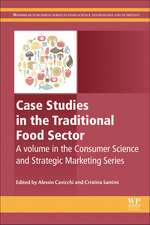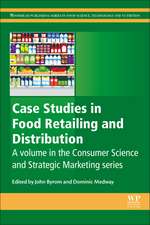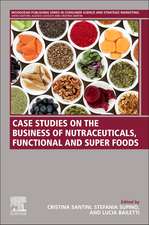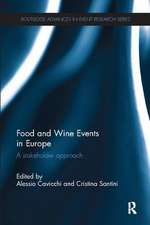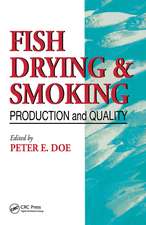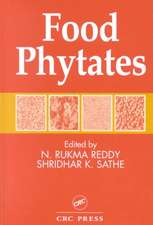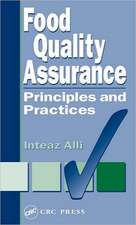Case Studies in the Wine Industry: Woodhead Publishing Series in Consumer Science and Strategic Marketing
Editat de Cristina Santini, Alessio Cavicchien Limba Engleză Paperback – 3 dec 2018
There is an emerging demand from wine industry professionals and undergraduate and postgraduate students who attend business and agricultural studies courses who want to gain practical information through real cases and field-based research.
- Bridges the gap between scholars and practitioners in understanding consumers of wine
- Allows scientists and professionals to make the most of R&D outcomes
- Advances consumer science research to address business problems in the wine industry
Preț: 666.88 lei
Preț vechi: 875.40 lei
-24% Nou
Puncte Express: 1000
Preț estimativ în valută:
127.60€ • 133.23$ • 105.61£
127.60€ • 133.23$ • 105.61£
Carte tipărită la comandă
Livrare economică 28 martie-11 aprilie
Preluare comenzi: 021 569.72.76
Specificații
ISBN-13: 9780081009444
ISBN-10: 0081009445
Pagini: 213
Dimensiuni: 152 x 229 x 16 mm
Greutate: 0.29 kg
Editura: ELSEVIER SCIENCE
Seria Woodhead Publishing Series in Consumer Science and Strategic Marketing
ISBN-10: 0081009445
Pagini: 213
Dimensiuni: 152 x 229 x 16 mm
Greutate: 0.29 kg
Editura: ELSEVIER SCIENCE
Seria Woodhead Publishing Series in Consumer Science and Strategic Marketing
Cuprins
1. Introduction
Part 1: Market Outlook, Factors and Trends
2. Wine sector: definitions and nuances from global to country analysis: A comparison between Old World, New World and Emerging Wine Countries from 2005 to current
3. Global trends in wine production and retailing
4. Consumer behavior towards wine products
5. R&D, the myth: where is research going? What is the role of consumer science as a business tool in the wine sector?
Part 2: New and innovative products: the role of consumer science
6. Ignoring Consumer Science? Three Cases from Austria about Philosophies, Gut Feeling and Intuitive Decision Making
7. What is the role of CS in helping new products development?
8. What are the benefits for a company that employs consumer science in product/process innovation?
Part 3: Sustaining the growth: consumer science and market growth
9. How can CS be employed in a market growth strategy?
10. How can CS be used for producing info that can be employed in strategy making?
Part 4: Mature products in a mature business
11. Rebranding Wine Using Sensory Profiling Data: A Case Study
12. How can firms use CS when their products achieve the peak of the product life cycle and they get into the decline phase?
13. How can firms transform their dog (BCG matrix) products into profitable ones by employing CS?
Part 5: Interpreting market dynamics and demand: consumer science as a means to achieve strategic information
14. How can CS be used for gaining info about consumers and the market?
15. How do firms process info?
16. How do firms use consumer science to optimize internal information flows and communication
17. Conclusion
Appendix
Further insights on methodological tools adopted in this book
Part 1: Market Outlook, Factors and Trends
2. Wine sector: definitions and nuances from global to country analysis: A comparison between Old World, New World and Emerging Wine Countries from 2005 to current
3. Global trends in wine production and retailing
4. Consumer behavior towards wine products
5. R&D, the myth: where is research going? What is the role of consumer science as a business tool in the wine sector?
Part 2: New and innovative products: the role of consumer science
6. Ignoring Consumer Science? Three Cases from Austria about Philosophies, Gut Feeling and Intuitive Decision Making
7. What is the role of CS in helping new products development?
8. What are the benefits for a company that employs consumer science in product/process innovation?
Part 3: Sustaining the growth: consumer science and market growth
9. How can CS be employed in a market growth strategy?
10. How can CS be used for producing info that can be employed in strategy making?
Part 4: Mature products in a mature business
11. Rebranding Wine Using Sensory Profiling Data: A Case Study
12. How can firms use CS when their products achieve the peak of the product life cycle and they get into the decline phase?
13. How can firms transform their dog (BCG matrix) products into profitable ones by employing CS?
Part 5: Interpreting market dynamics and demand: consumer science as a means to achieve strategic information
14. How can CS be used for gaining info about consumers and the market?
15. How do firms process info?
16. How do firms use consumer science to optimize internal information flows and communication
17. Conclusion
Appendix
Further insights on methodological tools adopted in this book









